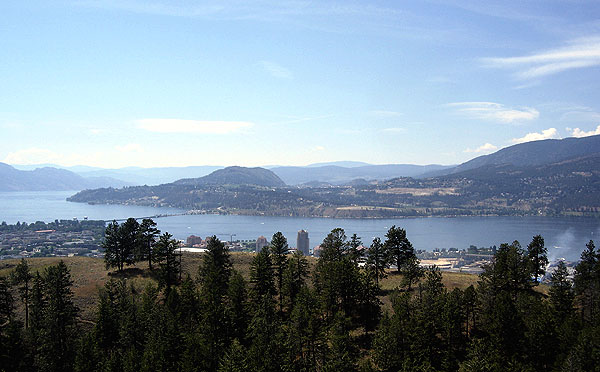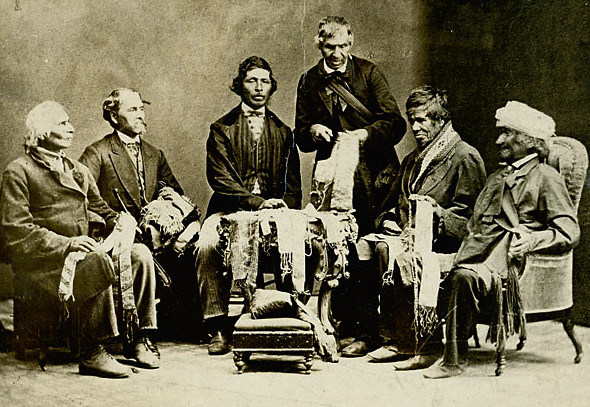|
Tsinstikeptum 9, British Columbia
Tsinstikeptum 9, usually referred to as Tsinstikeptum Indian Reserve No. 9, is one of two Indian Reserves of the Westbank First Nation located adjacent to West Kelowna, British Columbia, Canada. It and Tsinstikeptum Indian Reserve No. 10 are jointly normally referred to as the Westbank Indian Reserve. Tsinstikeptum Indian Reserve No. 9 is located six miles southwest of Kelowna proper, adjacent to McDougall Creek. The reserve is 641.80 ha in area. The southernmost portion of the reserve lies on the shores of Okanagan Lake. Demographics In the Canada 2011 Census, Tsinstikeptum 9 had a population of 5,882, making it Canada's second-most populous Indian reserve that is designated as a census subdivision (following Six Nations 40 in Ontario). However, the majority of Tsinstikeptum 9's residents are non-aboriginal. The total registered population of the Westbank First Nation among all five of its reserves, including off-reserve members, is only 784. [...More Info...] [...Related Items...] OR: [Wikipedia] [Google] [Baidu] |
Indian Reserves
In Canada, an Indian reserve (french: réserve indienne) is specified by the '' Indian Act'' as a "tract of land, the legal title to which is vested in Her Majesty, that has been set apart by Her Majesty for the use and benefit of a band." Indian reserves are the areas set aside for First Nations, an indigenous Canadian group, after a contract with the Canadian state ("the Crown"), and are not to be confused with land claims areas, which involve all of that First Nations' traditional lands: a much larger territory than any reserve. Demographics A single "band" (First Nations government) may control one reserve or several, while other reserves are shared between multiple bands. In 2003, the Department of Indian and Northern Affairs stated there were 2,300 reserves in Canada, comprising . According to Statistics Canada in 2011, there are more than 600 First Nations/Indian bands in Canada and 3,100 Indian reserves across Canada. Examples include the Driftpile First Nation, wh ... [...More Info...] [...Related Items...] OR: [Wikipedia] [Google] [Baidu] |
Westbank First Nation
The Westbank First Nation is a self-governing First Nations band in the Okanagan region of British Columbia, Canada, and is one of eight bands that comprise the Okanagan Nation Alliance. Westbank First Nation (WFN) is governed by one chief (Christopher R. Derickson) and four councillors, elected every three years by WFN membership (the current term is 2019-2022). As of April 2019, WFN's membership totaled 914 members, and employs more than 200 people. Government Westbank reserves were once part of the Okanagan Indian Band until they separated and became an independent band in 1963. 27 years later, in 1990, a framework agreement was entered into which allowed community-based self-government to be negotiated. On May 6, 2004, the Westbank First Nation Self-Government Act (Bill C-11) received royal assent and became law. WFN self-government officially came into force April 1, 2005. Following the enactment of self-government, WFN members developed the Westbank First Nation constitut ... [...More Info...] [...Related Items...] OR: [Wikipedia] [Google] [Baidu] |
West Kelowna
West Kelowna, formerly known as Westbank and colloquially known as Westside, is a city in British Columbia's Okanagan Valley. The city encompasses several distinct neighbourhoods, including Casa Loma, Gellatly, Glenrosa, Lakeview Heights, Shannon Lake, Smith Creek, Rose Valley, Westbank, and West Kelowna Estates. West Kelowna had an estimated population of 34,883 (BC Statistics) as of December 31, 2018. West Kelowna incorporated December 6, 2007, as Westside District Municipality, so chosen to reflect the name of a former Central Okanagan Regional District rural electoral area. On January 30, 2009, the municipality was renamed West Kelowna. The municipality was reclassified as the City of West Kelowna on June 26, 2015. The general area is also sometimes referred to as Greater Westside, Westbank, and Westside. History Westside District Municipality was established December 6, 2007, following a referendum on June 16, 2007, in which Westside residents voted to incorporate by ... [...More Info...] [...Related Items...] OR: [Wikipedia] [Google] [Baidu] |
British Columbia
British Columbia (commonly abbreviated as BC) is the westernmost province of Canada, situated between the Pacific Ocean and the Rocky Mountains. It has a diverse geography, with rugged landscapes that include rocky coastlines, sandy beaches, forests, lakes, mountains, inland deserts and grassy plains, and borders the province of Alberta to the east and the Yukon and Northwest Territories to the north. With an estimated population of 5.3million as of 2022, it is Canada's third-most populous province. The capital of British Columbia is Victoria and its largest city is Vancouver. Vancouver is the third-largest metropolitan area in Canada; the 2021 census recorded 2.6million people in Metro Vancouver. The first known human inhabitants of the area settled in British Columbia at least 10,000 years ago. Such groups include the Coast Salish, Tsilhqotʼin, and Haida peoples, among many others. One of the earliest British settlements in the area was Fort Victoria, established ... [...More Info...] [...Related Items...] OR: [Wikipedia] [Google] [Baidu] |
Canada
Canada is a country in North America. Its ten provinces and three territories extend from the Atlantic Ocean to the Pacific Ocean and northward into the Arctic Ocean, covering over , making it the world's second-largest country by total area. Its southern and western border with the United States, stretching , is the world's longest binational land border. Canada's capital is Ottawa, and its three largest metropolitan areas are Toronto, Montreal, and Vancouver. Indigenous peoples have continuously inhabited what is now Canada for thousands of years. Beginning in the 16th century, British and French expeditions explored and later settled along the Atlantic coast. As a consequence of various armed conflicts, France ceded nearly all of its colonies in North America in 1763. In 1867, with the union of three British North American colonies through Confederation, Canada was formed as a federal dominion of four provinces. This began an accretion of provinces an ... [...More Info...] [...Related Items...] OR: [Wikipedia] [Google] [Baidu] |
Tsinstikeptum 10
Tsinstikeptum 10, usually referred to as Tsinstikeptum Indian Reserve No. 10, is one of two Indian Reserves of the Westbank First Nation located in West Kelowna, British Columbia, Canada. It and Tsinstikeptum Indian Reserve No. 9 are jointly normally referred to as the Westbank Indian Reserve. Tsinstikeptum Indian Reserve No. 10, which is 339 ha. in area, is located opposite the City of Kelowna proper, across Okanagan Lake. Demographics As a census subdivision in the Canada 2011 Census, Tsinstikeptum 10 had a population of 1,186, of which the majority were non-aboriginal residents. The total registered population of the Westbank First Nation among all five of its reserves, including off-reserve members, is only 784. [...More Info...] [...Related Items...] OR: [Wikipedia] [Google] [Baidu] |
Kelowna
Kelowna ( ) is a city on Okanagan Lake in the Okanagan Valley in the southern interior of British Columbia, Canada. It serves as the head office of the Regional District of Central Okanagan. The name Kelowna derives from the Okanagan word ''kiʔláwnaʔ'', referring to a male grizzly bear. Kelowna is the province's third-largest metropolitan area (after Vancouver and Victoria), while it is the seventh-largest city overall and the largest in the Interior. It is the 20th-largest metropolitan area in Canada. The city proper encompasses , and the census metropolitan area . Kelowna's estimated population in 2020 is 222,748 in the metropolitan area and 142,146 in the city proper. After many years of suburban expansion into the surrounding mountain slopes, the city council adopted a long-term plan intended to increase density instead - particularly in the downtown core. This has resulted in the construction of taller buildings, including One Water Street - a 36-storey building that ... [...More Info...] [...Related Items...] OR: [Wikipedia] [Google] [Baidu] |
Okanagan Lake
Okanagan Lake ( oka, kɬúsx̌nítkw) is a lake in the Okanagan Valley of British Columbia, Canada. The lake is long, between wide, and has a surface area of 348 km2 (135 sq. mi.). Hydrography Okanagan Lake is called a fjord lake as it has been carved out by repeated glaciations. Although the lake contains numerous lacustrine terraces, it is not uncommon for the lake to be deep only offshore. Major inflows include Mission, Vernon, Trout, Penticton, Equesis, Kelowna, Peachland and Powers Creeks. The lake is drained by the Okanagan River, which exits the lake's south end via a canal through the city of Penticton to Skaha Lake, whence the river continues southwards into the rest of the South Okanagan and through Okanogan County, Washington to its confluence with the Columbia. The lake's maximum depth is near Grant Island (Nahun Weenox). There are three other islands: one known as Rattlesnake Island, much farther south by Squally Point. The other two are near Grant I ... [...More Info...] [...Related Items...] OR: [Wikipedia] [Google] [Baidu] |
Census Subdivision
The census geographic units of Canada are the census subdivisions defined and used by Canada's federal government statistics bureau Statistics Canada to conduct the country's quinquennial census. These areas exist solely for the purposes of statistical analysis and presentation; they have no government of their own. They exist on four levels: the top-level (first-level) divisions are Canada's provinces and territories; these are divided into second-level census divisions, which in turn are divided into third-level census subdivisions (often corresponding to municipalities) and fourth-level dissemination areas. In some provinces, census divisions correspond to the province's second-level administrative divisions such as a county or another similar unit of political organization. In the prairie provinces, census divisions do not correspond to the province's administrative divisions, but rather group multiple administrative divisions together. In Newfoundland and Labrador, the bou ... [...More Info...] [...Related Items...] OR: [Wikipedia] [Google] [Baidu] |
Six Nations Of The Grand River First Nation
Six Nations (or Six Nations of the Grand River, french: Réserve des Six Nations, see, Ye:i’ Níónöëdzage:h) is demographically the largest First Nations reserve in Canada. As of the end of 2017, it has a total of 27,276 members, 12,848 of whom live on the reserve. It is the only reserve in North America that has representatives of all six Haudenosaunee nations living together. These nations are the Mohawk, Cayuga, Onondaga, Oneida, Seneca and Tuscarora. Some Lenape (formerly known as Delaware) also live in the territory. The Six Nations reserve is bordered by the County of Brant, Norfolk County, and Haldimand County, with a subsection reservation, the New Credit Reserve, located within its boundaries. The acreage at present covers some near the city of Brantford, Ontario. This represents approximately 5% of the original of land granted to the Six Nations by the 1784 Haldimand Treaty. History Many of the Haudenosaunee people allied with the British during the Ameri ... [...More Info...] [...Related Items...] OR: [Wikipedia] [Google] [Baidu] |
List Of Indian Reserves In Canada
Canada has numerous Indian reserves for First Nations people, which were mostly established by the ''Indian Act'' of 1876 and have been variously expanded and reduced by royal commissions since. They are sometimes incorrectly called by the American term " reservations". Alberta British Columbia Manitoba * A Kwis Ki Mahka Indian Reserve — Fox Lake Cree Nation * Amik Wachink Sakahikan — Garden Hill First Nation * Anderson — Norway House Cree Nation * Andrew Bay — God's Lake First Nation * Bella Lake Exchange Lands — Garden Hill First Nation * Berens River 13 — Berens River First Nation * Birch Landing — Brokenhead Ojibway Nation * Birdtail Creek 57 — Birdtail Sioux First Nation * Birdtail Hay Lands 57A — Birdtail Sioux First Nation * Black River 9 — Black River First Nation * Black Sturgeon — Marcel Colomb First Nation * Bloodvein 12 — Bloodvein First Nation * Bottle Lake 61B — Keeseekoowenin Ojibway First Nation * Broc ... [...More Info...] [...Related Items...] OR: [Wikipedia] [Google] [Baidu] |





